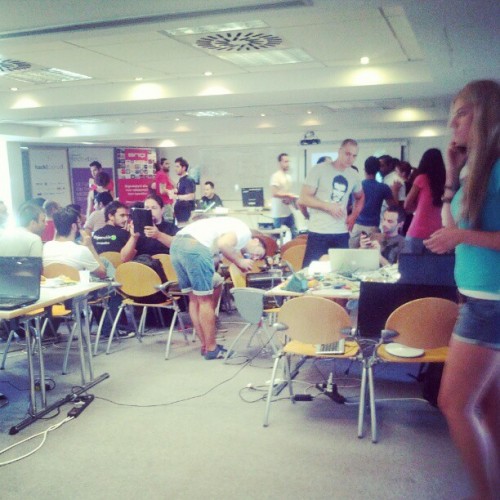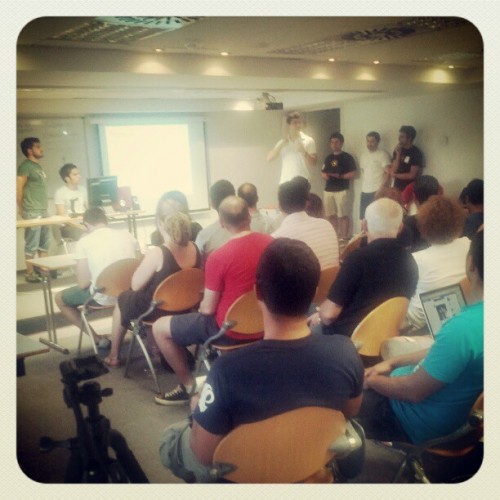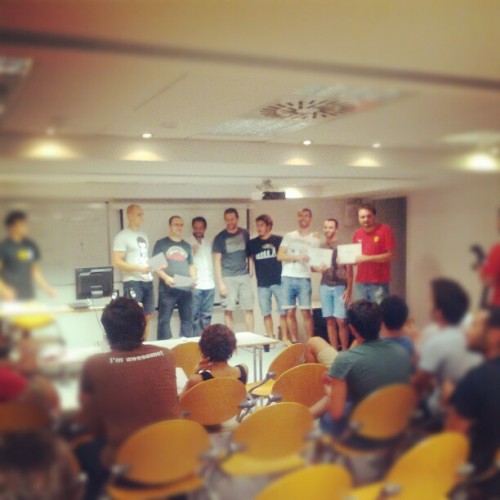As I mentioned in a post yesterday, I was going to see the presentations of project on the first Cyprus hackathon. And I went. And it was awesome!
It was a bit tricky to find and I nearly missed it, as I didn’t know all the buildings that belong to Cyprus University of Technology. Luckily, I spotted a bunch of people in black t-shirts outside of the building. And there are only three groups of people that wear black t-shirts: geeks, hard rock fans, and policemen. I approached carefully, and once I knew these weren’t the police, I knew I would blend in and have a good time.
The presentations were scheduled for 17:30, but all teams were finishing up, and people were tired, and there were a couple of technical issues that caused a small delay, so the actual starting time was more like 6-6:15. Nobody minded though, I think. There was plenty of drinks and food available for anyone who felt bored.
I wasn’t bored at all. It was fun to see so many geeks in one room. There was plenty of hardware and software around, and there were even a few people that I knew from before. I spoke with Marina Theodotou of Curveball fame, who is better known as founder and curator of TEDxNicosia. She gave me some good news in regards to TED – there will be another event, probably either in December or January. Then I also spoke a bit with Julia Papageorgiou of JPP Marketing, who was also one of the sponsors of the event, Christos, who was my classmate back in Intercollege and who I haven’t seen since, and Marios, with who we met a few times over the Ubuntu-Cy events.
Anyways, let me get back on track. Initially, there were about 15 teams. 11 of them made it to the finish. One of the finishes had some last minute problems, so they did not present. That left us with 10 project presentations. Here they are:
Momendos is a mobile application that allows its users to record memories, thoughts and ideas correlated with a geographical place. There is a way to browse your own records, as well as other people’s public notes when you are at or close to a specific place. The application is integrated with Facebook, and will also provide a bridge to other social networks in the future.
The presentation seemed OK, but the project, I guess, is rather pointless, since Facebook, Twitter, Google+ and Foursquare all already provide the functionality of posting geographically tagged notes. It escaped me why someone would want to have yet another app for this. But then again, we do already have multiple apps that do this, and each one of them has some sort of user base.
Xlook
Xlooks is also a mobile application. This one provided remote access from mobile devices to computers behind the firewall, using Dropbox API. The team demonstrated three pieces of functionality – remote commands (Liux shell kind), camera images, and screenshots.
While nothing special, this was a not bad at all idea and result for 30-something hours of work.
MrPoint
MrPoint is a website project that attempted to map all sorts of Cyprus events. The idea was to get data from several sources and places them on the same map, providing access by category or location. The interesting bit was that when the team recognized the problem of locating events in Cyprus online resources, and started importing data from a few resources, they came to realize that even those resources that are there, don’t really have a good way of sharing that data. Case in point was OnThisIsland.com CyprusEvents website (thanks to Christos for the correction), which they used as a source of data. Though the site itself has a geographical mapping of venues an events, the data is not really shared through any specific API, so the team had to a bit of reverse engineering.
The niche of events calendaring in Cyprus is close to me since the times I had a project of my own that attempted to improve the situation. And while the area improved a lot in recent years, it’s still not quite there yet.
I also think the team deserved some bonus points for implementing the website in responsive design, so that it would look equally well in desktop browser and on a mobile device.
Robogammon
Robogammon was the only project from all the presented that haven’t been completely developed at this hackathon. The project is around a year old already, and has seen plenty of effort. But there were still parts built during the event, so it deserved to be showcased. The essence of the project is a robot that plays the game of backgammon. It’s complete with advanced game software, a camera over the game board to identify the moves, and a robot hand to move the pieces for the computer player. Altogether it looked pretty awesome and employed some interesting technology, both in hardware (Lego Mindstorms, Adruino) and in software (Google APIs, neural networks, etc).
Here is a YouTube video demonstrating the robogammon in action.
[youtube=http://www.youtube.com/watch?v=N5lulmwHzpk]
Tomash and the marvelous creations
Tomash was a one guy team. Enthusiastic and creative, the guy came to hackathon without any preset ideas, and managed to come up and implement not one, not two, but three projects. Unluckily, there was a technical problem right before the presentation with one of the projects – a speech to Morse code converter, but then someone reminded of a YouTube video that was taken of the project in action before the presentation time. Here it is, a connection between Google speech-to-text API, a Morse code converter, and an Adruino with a tiny speaker attached.
[youtube=http://www.youtube.com/watch?v=dTmzzGm-3eI]
The other projects were even cooler. Both utilized laptop camera for two separate things. One was to transform an image from the camera to a custom made very low resolution LED display (8×8 pixels, 8 colors), which was working better with colors than actual images. And another was the abstract music project, where a sound waves would be controlled by colorized post-it notes moved up, down, left, and right in front of the camera. While not very practical, that was still pretty awesome.
I had a brief discussion with Tomash after the presentations and it was interesting to hear about the problems that he had while doing the projects. In particular, one where he had to optimize the protocol for the LED display, because it was too slow to work on a LED-by-LED update and had to be switched to a frame-by-frame instead.
RePilo
RePilo is an RFID-based project. The guys developed a mobile application that would quickly count points in card games, using a special deck of card with embedded RFID tags in them. One thing that this project demonstrated was how much faster an RFID reader is over a camera-based bar code reader. And in the discussion that started after the presentation it was suggested that this technology would probably make more sense when embedded into a casino table rather than a mobile phone.
Scan’n’Shop
This was another RFID-based project. A scanner device for home that would be used to scan items you ran out of, to automatically build a shopping list. Not too creative in terms of the project idea, but the guys did a great job with presentation – it was funny and entertaining, while illustrating how horrible some of the consumer electronics might get, and how the world has moved on from single-use device to multi-function appliances.
HackCy Defender
HackCy Defender is a mobile game built by the team from Wajee Mobile Ltd. There were a couple of things cool about it. First was that it was developed with a specific story for the hackathon event itself – a bunch of monsters trying to ruin the event, and the player who would need to protect the hackathon by killing the monsters. The second thing was that the whole shoot ’em up game was put over an augmented reality browser, so you would see monsters in the room in which you currently were.
There were a few other bits that I half-caught, related to multi-player mode, where several players would work together to clear the same room of monsters; and something about Google mapping API to control monsters navigation paths and such. Pretty awesome for a project of only 30-something hours and a team of two people.
aNetMon
aNetMon is a security application for Android devices. It provides intrusion detection, permission monitoring, network status monitoring, activity logging, and other related functionality. As with many other security applications, it is aimed more at security conscious technical people rather then an average user, but I guess it’s all good non-the-less.
Submarine
This was the project with the largest team and with the most ambitious goal – to build a submarine that would do HD video broadcast from under water. This one had plenty of challenges and had to mix hardware (submarine with motors, computer on board, HD video camera, Wii wheel for motor navigation), software, and even mobile development (Android device to control the camera). There were plenty of challenges for the team – getting hardware in Cyprus on Saturday afternoon and Sunday morning is in a class of its own, not to mention mixing digital technology with water. But it was nice to see that they worked through a whole lot of them and in such a short time.
By the way, this project was utilizing another cool piece of hardware – Rasberry Pi.
Parking Finder
This was interesting. Much like Tomash above these guys came in without any preset idea. However the muse wasn’t theirs this time, as they struggle with finding an idea until almost 6pm of Saturday. That meant that they had much less time for the implementation than the other teams. But it was still cool to see what they came up with. Parking Finder is a mobile application that applies statistical analysis to tell you if the parking space has any vacancies for your car. Much unlike many other projects, these guys also came up with the monetization plan for the app with location-based advertising.
So these were the presentations. After the presentations were over, the panel of judges went to another room to decide on who should get the awards – a tough choice to make. The rest of us did the people’s vote. Eventually, the prizes went to the submarine team, HackCy Defender team, and Tomash. But I think everyone won something. At the very least, each and everyone got the respect of own peers.
The event was very well organized, and provided priceless networking opportunities. It was inspiring to see all these people in the room, all of who were exhausted, in desperate need of a shower and sleep, and yet with a spark of excitement in their eyes, proud of a who they were and what they did.
Even after the official part was over, people didn’t rush home – many stayed for a few beers and discussion, exchanged contact information, and such. I’m sure once the organizers and participants will get some sleep, they’ll start planning the next event of this kind. And hopefully, next time I’ll be able to attend the coding part as well.
Well done guys. Respect.



Great summary of all the projects by @mamchenkov: http://t.co/rK4ahJ6Z
RT @hackcyprus: Great summary of all the projects by @mamchenkov: http://t.co/rK4ahJ6Z
Vasileios Mitrousis liked this on Facebook.
RT @hackcyprus: Great summary of all the projects by @mamchenkov: http://t.co/rK4ahJ6Z
RT @hackcyprus: Great summary of all the projects by @mamchenkov: http://t.co/rK4ahJ6Z
RT @hackcyprus: Great summary of all the projects by @mamchenkov: http://t.co/rK4ahJ6Z
RT @hackcyprus: Great summary of all the projects by @mamchenkov: http://t.co/rK4ahJ6Z
RT @hackcyprus: Great summary of all the projects by @mamchenkov: http://t.co/lczOv1Po
Another great perspective from Leonid, this one on the first Hackathon in Cyprus.
A nice overview of all the project presentations. It was nice to catch up with you as well Leonid and we hope to see you in upcoming events.
ps. I can think of a couple of other groups wearing black t-shirt: cool new yorkers and people in mourning…
Thanks Marina. :)
Cool stuff. Thanks for the review. :)
You’r welcome. :)
Some very interesting projects and very skilled people! I’m so down for the next event! So true about lack of APIs in Cyprus, opening up data should be an objective for all of us. Data infrastructure is key for developing a modern and healthy startup ecosystem as it allows for asymmetric innovation, especially in such a small place. It’s what has allowed the valley to blossom allowing industry-wide economies of scale and healthy co-dependence.
Personally, I feel that in our small economy, the government has one of the biggest budgets around and also the capacity for innovation. It also has plenty of data we have already paid to collect and record. We should be able to create new services with innovative business models that contribute more value from taxpayers money to the economy.
While I’m not sure Karl Popper’s, open society idea is completely realistic, i do think that there are different shades of open that we should definitely be investigating.
Imagine how many products you could create with an API for the car register, or land registry!
Good points Dimitri. I would indeed love to get my hands on the car or land registry data.
Vladimir Ivashchenko liked this on Facebook.
HackCyprus – A review http://t.co/liXDc9ze
RT @hackcyprus: Great summary of all the projects by @mamchenkov: http://t.co/rK4ahJ6Z
Complete and thorough as usual. As you said priceless. Goes to show that new energy exists only to be tapped for creativity. I know most you People that don’t read blogs or have a twitter account walking around in public ministries…take note and ‘Open that Data’ in other form than paper.
“@opencoffeegr: #HackCyprus – A review http://t.co/2KvFotaB” @thewritehand77